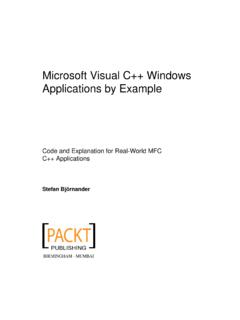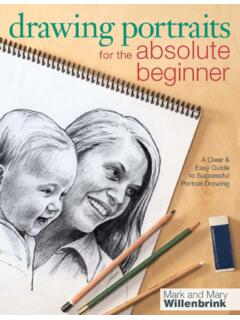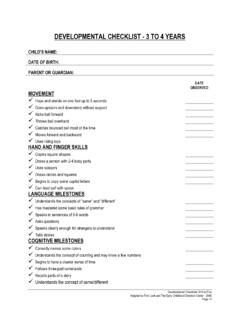Transcription of Programming Computer Vision with Python
1 Programming Computer Vision with Python Jan Erik Solem Published by O'Reilly Media Beijing Cambridge Farnham K ln Sebastopol Tokyo Preface Today, images and video are everywhere. Online photo-sharing sites and social networks have them in the billions. Search engines will produce images of just about any conceivable query. Practically all phones and computers come with built-in cameras. It is not uncommon for people to have many gigabytes of photos and videos on their devices. Programming a Computer and designing algorithms for understanding what is in these images is the field of Computer Vision . Computer Vision powers applications like image search, robot navigation, medical image analysis, photo management, and many more.
2 The idea behind this book is to give an easily accessible entry point to hands-on Computer Vision with enough understanding of the underlying theory and algorithms to be a foundation for students, researchers, and enthusiasts. The Python Programming language, the language choice of this book, comes with many freely available, powerful modules for handling images, mathematical computing, and data mining. When writing this book, I have used the following principles as a guideline. The book should: Be written in an exploratory style and encourage readers to follow the examples on their computers as they are reading the text. Promote and use free and open software with a low learning threshold.
3 Python was the obvious choice. Be complete and self-contained. This book does not cover all of Computer Vision but rather it should be complete in that all code is presented and explained. The reader should be able to reproduce the examples and build upon them directly. Be broad rather than detailed, inspiring and motivational rather than theoretical. In short, it should act as a source of inspiration for those interested in Programming Computer Vision applications. Prerequisites and Overview This book looks at theory and algorithms for a wide range of applications and problems. Here is a short summary of what to expect. What You Need to Know Basic Programming experience.
4 You need to know how to use an editor and run scripts, how to structure code as well as basic data types. Familiarity with Python or other scripting languages like Ruby or Matlab will help. Basic mathematics. To make full use of the examples, it helps if you know about matrices, vectors, matrix multiplication, and standard mathematical functions and concepts like derivatives and gradients. Some of the more advanced mathematical examples can be easily skipped. What You Will Learn Hands-on Programming with images using Python . Computer Vision techniques behind a wide variety of real-world applications. Many of the fundamental algorithms and how to implement and apply them yourself.
5 The code examples in this book will show you object recognition, content-based image retrieval, image search, optical character recognition, optical flow, tracking, 3D. reconstruction, stereo imaging, augmented reality, pose estimation, panorama creation, image segmentation, de-noising, image grouping, and more. Chapter Overview Chapter Overview Chapter 1. Introduces the basic tools for working with images and the central Python modules used in the book. This chapter also covers many fundamental examples needed for the remaining chapters. Chapter 2. Explains methods for detecting interest points in images and how to use them to find corresponding points and regions between images.
6 Chapter 3. Describes basic transformations between images and methods for computing them. Examples range from image warping to creating panoramas. Chapter 4. Introduces how to model cameras, generate image projections from 3D space to image features, and estimate the camera viewpoint. Chapter 5. Explains how to work with several images of the same scene, the fundamentals of multiple-view geometry, and how to compute 3D reconstructions from images. Chapter 6. Introduces a number of clustering methods and shows how to use them for grouping and organizing images based on similarity or content. Chapter 7. Shows how to build efficient image retrieval techniques that can store image representations and search for images based on their visual content.
7 Chapter 8. Describes algorithms for classifying image content and how to use them to recognize objects in images. Chapter 9. Introduces different techniques for dividing an image into meaningful regions using clustering, user interactions, or image models. Chapter 10. Shows how to use the Python interface for the commonly used OpenCV Computer Vision library and how to work with video and camera input. There is also a bibliography at the back of the book. Citations of bibliographic entries are made by number in square brackets, as in [20]. Introduction to Computer Vision Computer Vision is the automated extraction of information from images. Information can mean anything from 3D models, camera position, object detection and recognition to grouping and searching image content.
8 In this book, we take a wide definition of Computer Vision and include things like image warping, de-noising, and augmented reality. [1]. Sometimes Computer Vision tries to mimic human Vision , sometimes it uses a data and statistical approach, and sometimes geometry is the key to solving problems. We will try to cover all of these angles in this book. Practical Computer Vision contains a mix of Programming , modeling, and mathematics and is sometimes difficult to grasp. I have deliberately tried to present the material with a minimum of theory in the spirit of as simple as possible but no simpler. The mathematical parts of the presentation are there to help readers understand the algorithms.
9 Some chapters are by nature very math-heavy (Chapter 4 and Chapter 5, mainly). Readers can skip the math if they like and still use the example code. Python and NumPy Python is the Programming language used in the code examples throughout this book. Python is a clear and concise language with good support for input/output, numerics, images, and plotting. The language has some peculiarities, such as indentation and compact syntax, that take getting used to. The code examples assume you have Python or later, as most packages are only available for these versions. The upcoming Python version has many language differences and is not backward compatible with Python or compatible with the ecosystem of packages we need (yet).
10 Some familiarity with basic Python will make the material more accessible for readers. For beginners to Python , Mark Lutz' book learning Python [20] and the online documentation at are good starting points. When Programming Computer Vision , we need representations of vectors and matrices and operations on them. This is handled by Python 's NumPy module, where both vectors and matrices are represented by the array type. This is also the representation we will use for images. A good NumPy reference is Travis Oliphant's free book Guide to NumPy [24]. The documentation at is also a good starting point if you are new to NumPy. For visualizing results, we will use the Matplotlib module, and for more advanced mathematics, we will use SciPy.







